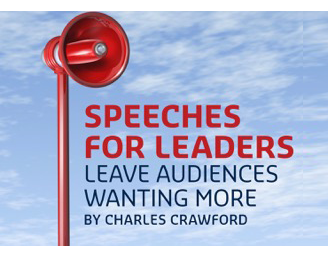+++ Update +++
Needless to say, mocking Mrs Clinton for barking like a dog (see below) opens a sinkhole of sexism. What drivel.
* * * * *
My book Speeches for Leaders (signed hard copy available outside North America here) has a whole chapter devoted to the issue of ‘risk’ in public speaking as the hardest question facing any speechwriter.
Here’s an extract:
Public speaking for leaders is different. Why? Because it pushes issues of risk and responsibility right to the fore.
When I am asked to coach someone to improve public speaking technique or prepare a significant speech I ask two questions, explaining that the second question is much harder than the first:
I’ve watched some of your speeches on YouTube. Do you want me to be honest with you in saying what I think? [They of course answer in the affirmative.]
Second question. Much harder. How good do you want to get? Do you want to be the best speaker on the day? Or the best in your organisation? Or an industry thought-leader? Or one of the best speakers in the world, a TED talks star performer?
This second question prompts a long pause. It’s one thing listening privately to someone being honest with you. It’s quite another thing to be honest about yourself.
How far do you really want to stand out from the crowd? What if your close colleagues and best friends start to think you’re showing off? What if you try something new and risky but it fails and leaves you embarrassed? What if you try something risky and it works triumphantly, so that you get offered that top position – are you ready for that new responsibility? These are genuinely difficult questions for anyone. They go right to the heart of a person and his/her private risk-taking instincts, ambitions and hopes.
Many prominent leaders are risk averse. Did anyone mention Hillary Clinton? They aim patiently to build up a credible public persona that offers as few as possible new areas of attack. A few bland but positive headlines are far better than negative stories and awkward photographs presenting words or gestures in a speech as inappropriate, even if in the room on the day they worked pretty well for the audience concerned.
Let’s look at four speeches that deliberately took risks, and succeeded.
I underestimated Mrs Clinton. Watch this:
She wants to make a point against her Republican opponents in a folksy way. So she tells a story about a dog trained to bark every time a politician lies, and illustrates it by making rather good barking noises herself.
Blimey.
The only thing we know in our uncertain world is that this will unleash myriad YouTube videos and Internet memes of Hillary Clinton talking about Benghazi or her email servers followed by sustained barking hollerin’ dogs. No doubt the Democrats will retaliate with similar attacks on Republican candidates.
Is this sort of thing good or bad for a public speaker in general and for her in particular?
No-one can say. It transcends all usual categories of analysis.
On the one hand it’s good because she is taking a risk, and in a sense owning it. And it is quite funny, as such things go. She wins points for boldness, confidence and approachability/humour.
On the other hand, does she need to lay herself so wide open to so many barking dog jokes at her expense, all of which will tend to reinforce already pretty deep US public misgivings about her honesty? She is already being framed as shifty and dishonest by plenty of Democrat supporters of Bernie. This new speech makes it so much easier to intensify that negative ‘framing’ effect across the board – barking dogs are an image so readily understood by every voter.
Speeches for Leaders:
Speeches of this magnitude soar above the pay–grade of the typical speechwriting team. Yes, words can be served up and fine–tuned to what the leader wants. But there comes a point when the leader has to own the product, and the risk.
Yup. And Hillary sure owns this one.










